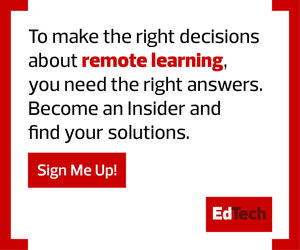The Challenges Administrators Must Consider
Of course, making education work in a new environment, where many students are remote while some are still in person, is a little tricky — and not just because of inconsistent technology.
Issues like stress, communication challenges, and a limited imagination as to what’s possible can prevent districts from excelling during this period.
The good news, though, is that this is where school administrators can shine through leadership and a tech-forward vision. FETC 2021 laid out a number of considerations for technology, leadership and management for the year ahead. Among them:
1. Understand the Challenges that Security Can Create for a Remote Student Body
With entire classrooms suddenly expected to work across dozens of environments, districts likely face a more complex attack surface than before. That means the ability to forge a strong cybersecurity response still matters — and that response, as emphasized by Lenny Schad, chief information and innovation officer for District Administration magazine, is not limited to the IT staff, but includes administrators and school boards as well. Additionally, security maintains a physical element even if a school is otherwise closed or in limited use. After all, as Ron Watson, district technology coordinator at New Jersey’s New Milford Public School District, recently learned, you never know when a tree might fall and cause a power outage — and how a cloud-enabled security system such as Verkada might help you catch it.
2. Emphasize Technological Ease of Use
When stakeholders are required to interact with your technology tools, an imperfect solution means headaches for everyone — students, teachers, administrators and even parents. Brian Cockrell, co-founder and product owner of the Intel Unite collaboration solution, noted during an FETC session the many challenges he faced helping his own daughter shoot a video and upload it for her class. “I’m tech savvy, and I had to jump through hoops and troubleshoot like no one’s business to figure it out,” he recalled. By working on improving infrastructure, schools can ease tech burdens for parents, students and others.
3. Focus on Building a Resilient Team to Combat Challenges
Teachers and administrators may find themselves under stress from the many changes that have taken place. Researcher and author Marcus Buckingham emphasized in his keynote session that helping staff manage change comes down to strong, clear messaging about what’s happening, along with frequent check-ins with team members. “Your challenge as a leader, as a senior leader, is not to dismiss people’s anxiety and demean it. … Your challenge as a leader is to take people’s anxiety and turn it into confidence,” he said.
4. Ensure “In-Between Moments” Still Happen
During his session last week, CDW Education Strategist Douglas Konopelko spoke of the importance of what happens between classes.; those moments when both teachers and students can interact off to the side still matter and need to be accounted for with technologies like Webex. “People used to bump into each other in the hallway all the time. They used to, you know, hop out of their classroom during their planning periods and be able to collaborate,” Konopelko explained. “So how are we recreating system structures and processes for that, so our teachers and our staff can continue to have the benefit of those in-between moments?”
5. Encourage Teachers to Think Creatively About Technology Use
It’s one thing to have a videoconferencing tool like Zoom at your classroom’s disposal, but another entirely to use it in experimental ways. One could see this dichotomy in the way Bryan Miller, the senior director of global strategic outreach for the robotics startup Wonder Workshop, talked about Zoom’s forthcoming features in an FETC session, suggesting approaches like using breakout rooms to build virtual museums for creating student-led history lessons. Miller emphasized that the technology provides room for creative thinking — if teachers are willing to use it. “Just because this is virtual instruction doesn’t mean that you have to take away the fun, the excitement, the way that you were doing it before,” he said.
EdTech is covering FETC, so bookmark this page for conference coverage. Follow @EdTech_K12 on Twitter for live updates, and join the conversation using the #FETC hashtag.











